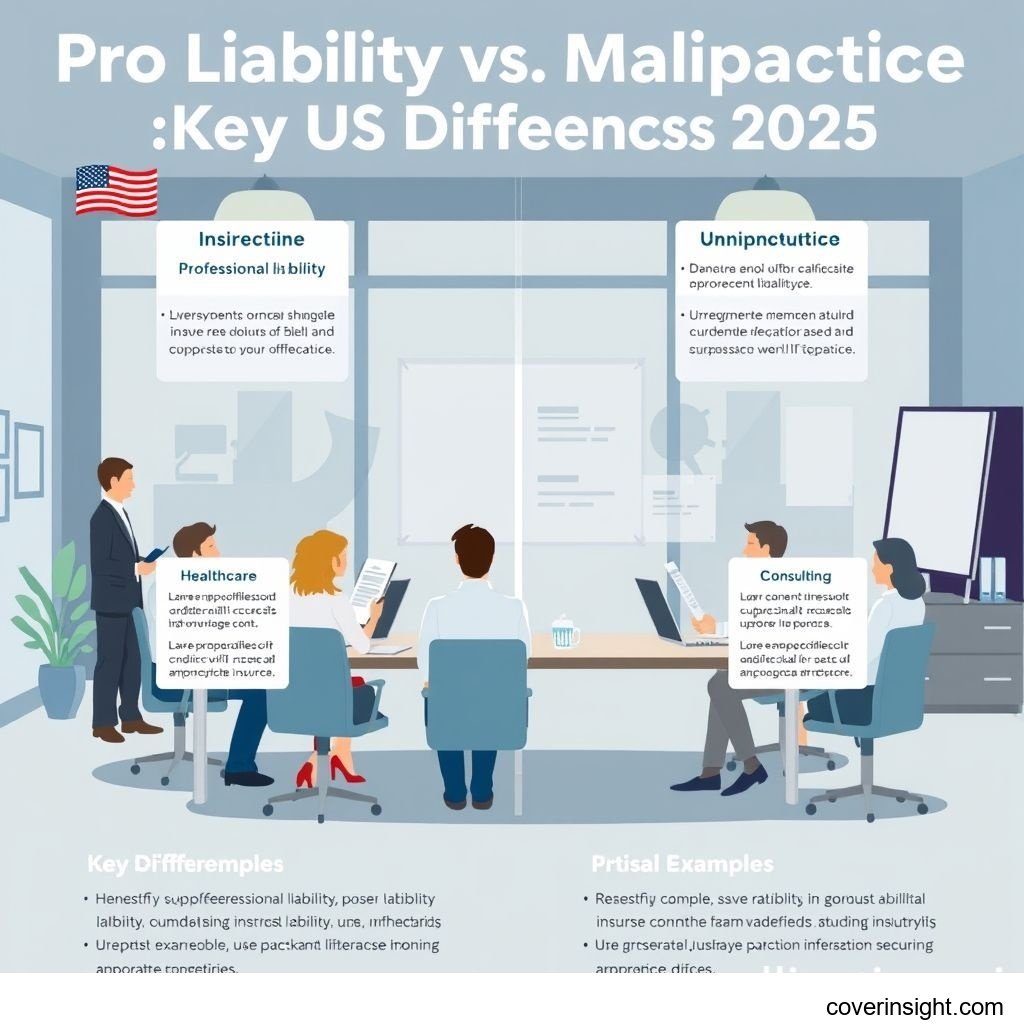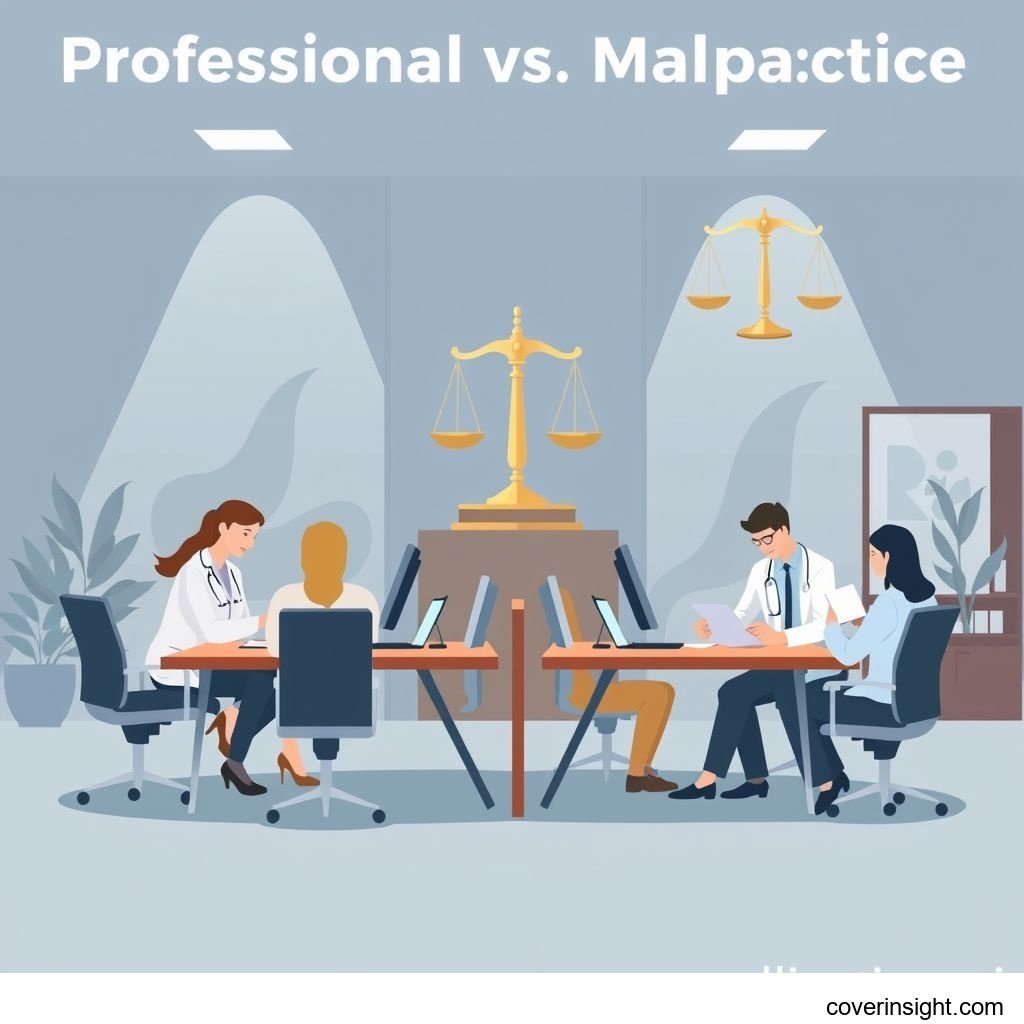Introduction
In the intricate landscape of the US professional world, understanding the nuances between professional liability and malpractice insurance is not just a legal formality but a crucial business imperative for 2025. While often used interchangeably, these two types of coverage address distinct risks, protecting professionals from the potentially devastating financial fallout of claims arising from their services. Whether you’re a seasoned medical practitioner, a budding tech consultant, or an established financial advisor, discerning the right type and scope of coverage is paramount to safeguarding your career, assets, and peace of mind.
Coverage Details
Navigating the specifics of what each policy covers—and, equally important, what it doesn't—is key to building a robust risk management strategy.
What’s Included
Professional liability insurance, sometimes referred to as "Errors & Omissions" (E&O) insurance, is designed for a broad spectrum of non-medical professionals. This includes, but isn't limited to, architects, engineers, consultants, real estate agents, accountants, IT service providers, and graphic designers. It typically covers claims of financial loss experienced by a client due to alleged:
-
Errors or omissions: Mistakes made or services not performed as expected.
-
Negligence: Failure to exercise the degree of care that a reasonably prudent person would have exercised in the same circumstances.
-
Misrepresentation: Providing inaccurate information.
-
Breach of contract: Failure to fulfill the terms of an agreement.
-
Poor advice: Professional advice that leads to client losses.
On the other hand, malpractice insurance is a specialized form of professional liability coverage specifically tailored for healthcare providers. This encompasses doctors, nurses, dentists, therapists, chiropractors, and other medical professionals. Its primary function is to protect these individuals from claims of bodily injury, illness, or death directly resulting from their professional negligence, errors, or omissions in patient care. This might include:
-
Misdiagnosis or delayed diagnosis: Failing to correctly identify a condition or delaying treatment.
-
Surgical errors: Mistakes made during medical procedures.
-
Medication errors: Incorrect prescription or administration of drugs.
-
Childbirth injuries: Negligence during delivery leading to harm to mother or baby.
-
Failure to obtain informed consent: Not properly explaining risks and benefits to a patient before treatment.
For more comprehensive insights into various insurance types and their global implications, explore our Insurance Resources Global.
Common Exclusions
While essential, neither professional liability nor malpractice insurance offers an all-encompassing shield. Both typically have critical exclusions that professionals must be aware of:
-
Intentional criminal acts or fraud: Deliberate wrongdoing is rarely covered.
-
Bodily injury or property damage (general liability): These policies generally don't cover non-professional liabilities, such as a client slipping and falling in your office (which falls under general liability insurance).
-
Employee injuries: Workers' compensation covers this.
-
Discrimination or harassment: Often handled by Employment Practices Liability (EPL) insurance.
-
Patent or copyright infringement (sometimes): Though some E&O policies for creative industries might include this, it's not standard.
-
Prior acts without specific coverage: Claims arising from services rendered before the policy's effective date, unless "prior acts" or "tail" coverage is specifically purchased.
-
Punitive damages: In some states, these are uninsurable by law, designed to punish the defendant, not compensate the victim.
Understanding these exclusions is vital to ensure you're not walking a tightrope without a safety net in critical areas.
Cost Analysis
The price tag on professional liability and malpractice insurance can vary dramatically, much like real estate across the country. It's never a one-size-fits-all situation.
Price Factors
Several key elements come into play when determining your premiums:
-
Profession/Specialty: This is arguably the biggest factor. A neurosurgeon, for instance, faces significantly higher malpractice premiums than a general practitioner due to the inherent risks and potential for large payouts. Similarly, a financial advisor managing large portfolios might pay more for professional liability than a freelance graphic designer.
-
Location: State laws, tort reform measures, and the general litigiousness of the local population profoundly impact costs. For example, states like New York and Florida have historically seen higher malpractice premiums due to their legal environments. A 2023 report from a credible legal research firm noted that medical malpractice payouts in some US regions, particularly the Northeast, consistently outpace the national average, directly influencing insurance costs.
-
Claims History: A history of previous claims will almost certainly lead to higher premiums, as insurers view you as a higher risk. A clean record, conversely, often earns you a discount.
-
Policy Limits and Deductibles: Choosing higher coverage limits (the maximum the insurer will pay) will increase your premium, while opting for a higher deductible (what you pay out-of-pocket before insurance kicks in) can lower it.
-
Business Size and Revenue: Larger firms with more employees or higher annual revenue generally face higher premiums due to increased exposure to risk.
-
Risk Management Practices: Implementing robust protocols, ongoing training, and clear client communication can demonstrate a commitment to reducing risk, potentially earning you more favorable rates.
Saving Tips
While you can't control every factor, there are smart strategies to manage your insurance costs effectively:
-
Shop Around: Don't just settle for the first quote. Different insurers have different underwriting appetites and pricing models. Using an independent broker who can compare multiple quotes is often the smartest move.
-
Increase Your Deductible: If you have a solid emergency fund, opting for a higher deductible can significantly reduce your annual premium. Just ensure it's an amount you can comfortably afford in a pinch.
-
Implement Robust Risk Management: For healthcare professionals, this means staying current with best practices, thorough documentation, and effective communication with patients. For other professionals, it could involve clear contracts, quality control processes, and ongoing education. Insurers look favorably upon proactive risk mitigation.
-
Bundle Policies: Sometimes, insurers offer discounts if you purchase multiple policies (e.g., general liability, professional liability, and business property) from them.
-
Join Professional Associations: Many professional organizations offer discounted insurance rates to their members as a perk. It's worth checking if your association has such a program.
-
Maintain a Clean Claims History: This goes without saying, but avoiding claims through diligent practice and excellent client service is the best way to keep your premiums down in the long run.
For localized guidance on insurance, including state-specific regulations and licensed providers, head over to US Insurance Home. You can also find valuable resources at your State Insurance Departments.
FAQs
How much does professional liability vs malpractice cost?
The cost varies wildly. Professional liability for a freelance consultant might be as low as a few hundred dollars annually, whereas a large engineering firm could pay tens of thousands. Malpractice insurance, especially for high-risk specialties like obstetrics or neurosurgery, can range from $20,000 to over $200,000 per year, depending on the state and specific practice.
What affects premiums?
Premiums are influenced by your profession's inherent risk, your specific specialty (for medical professionals), your claims history, the policy limits and deductibles you choose, your geographical location, and your proactive risk management strategies.
Is it mandatory?
Legally, it depends on your profession and state. For many non-medical professionals, professional liability insurance isn't legally mandatory, but client contracts or professional associations often require it. For instance, an architect won't get a major project without E&O coverage. For healthcare providers, while some states may not explicitly mandate malpractice insurance for all licensees, hospitals and healthcare systems almost universally require it as a condition of privileges. In essence, it's mandatory in practice for most.
How to choose?
Start by assessing your specific risks. What kind of errors could realistically lead to a claim against you? Research reputable insurers that specialize in your field. Consult with an experienced insurance broker who understands both your profession and the local legal landscape. Review policy terms carefully, paying close attention to inclusions, exclusions, and limits. Don't be afraid to ask plenty of questions, ensuring you're covering your bases. For regulatory insights, the National Association of Insurance Commissioners is an excellent resource.
Consequences of no coverage?
Operating without adequate coverage is akin to playing Russian roulette with your financial future. If a claim arises and you're uninsured, you'll be personally responsible for all legal defense costs, settlements, or judgments. This can easily run into hundreds of thousands or even millions of dollars, leading to bankruptcy, seizure of personal assets, and potentially the loss of your professional license. The hit to your reputation alone can be career-ending.
Author Insight & Experience
Based on my experience living in the US and observing the relentless march of litigation, securing the right professional liability or malpractice insurance isn't just about ticking a box; it's about building a robust shield around your livelihood. I've seen firsthand how a single, unforeseen claim, whether it's a doctor facing a complex malpractice suit or a small tech firm getting hit with an E&O claim over a software glitch, can completely derail a career or business. It’s not just the payout; it’s the legal fees, the time commitment, and the sheer mental toll. Investing in comprehensive coverage, truly understanding what you’re buying, and consistently practicing due diligence are the best forms of defense. It’s the ultimate "peace of mind" policy in a world where things can, and sometimes do, go sideways.








Comments